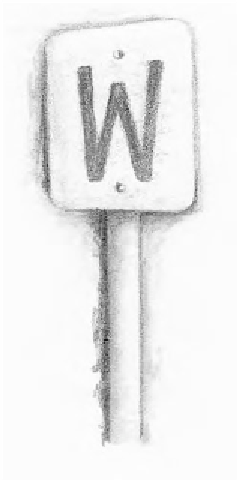Travel Reference
In-Depth Information
Mileposts
These are the most common—and, in many ways, the most
important—of all railroad signs. It might take you a few minutes
to spot them because they don't all look the same. But as the
name implies, there will be one every mile. Some are white posts
imprinted with black numerals; others will just be numbers the
size of postcards fastened to a metal stake; still others may simply
be stenciled onto square sheets of metal and fastened to one of the
“telephone poles” running alongside the tracks. Most mileposts
are positioned right next to the track, so you'll need to get close
up to the window to see them. In any event, you'll quickly be
able to identify them because they're
numbered in sequence, indicating the
number of miles from that spot to a
major terminus. Depending on which
direction you're traveling, the num-
bers will get bigger or smaller, one
mile at a time.
Mileposts are important because
they enable the railroad to pinpoint
a location along a route. For exam-
ple, before starting out on the day's
run, the engineer might be given train
orders telling him he can expect to
find work crews on the track between
mileposts 745 and 749. It works the
other way, too. If the engineer notices
any kind of problem en route, he can
radio the dispatcher and refer to a
specific milepost.
You can make use of the mile-
posts to figure out how fast the train
is moving. There's a simple formula
This sign lets the engineer know
that there is a grade crossing
up ahead and that he or she
must blow the whistle to warn
automobile traffic.











Search WWH ::

Custom Search